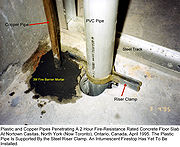
Riser clamp
Encyclopedia


Piping
Within industry, piping is a system of pipes used to convey fluids from one location to another. The engineering discipline of piping design studies the efficient transport of fluid....
at each floor level. The devices are placed around the pipe and integral fasteners are then tightened to clamp them onto the pipe. The friction
Friction
Friction is the force resisting the relative motion of solid surfaces, fluid layers, and/or material elements sliding against each other. There are several types of friction:...
between the pipe and riser transfers the weight of the pipe through the riser to the building structure. Risers are generally located at floor penetrations, particularly for continuous floor slabs such as concrete. They may also be located at some other interval as dictated by local building codes or at intermediate intervals to support plumbing which has been altered or repaired. Heavier piping types such as cast iron require more frequent support. Ordinarily, riser clamps are made of carbon
Carbon
Carbon is the chemical element with symbol C and atomic number 6. As a member of group 14 on the periodic table, it is nonmetallic and tetravalent—making four electrons available to form covalent chemical bonds...
steel
Steel
Steel is an alloy that consists mostly of iron and has a carbon content between 0.2% and 2.1% by weight, depending on the grade. Carbon is the most common alloying material for iron, but various other alloying elements are used, such as manganese, chromium, vanadium, and tungsten...
and individually sized to fit certain pipe sizes. The term "riser" is typically used to refer to vertical runs of pipes, electrical conduit
Electrical conduit
An electrical conduit is an electrical piping system used for protection and routing of electrical wiring. Electrical conduit may be made of metal, plastic, fiber, or fired clay. Flexible conduit is available for special purposes....
and tubes.

